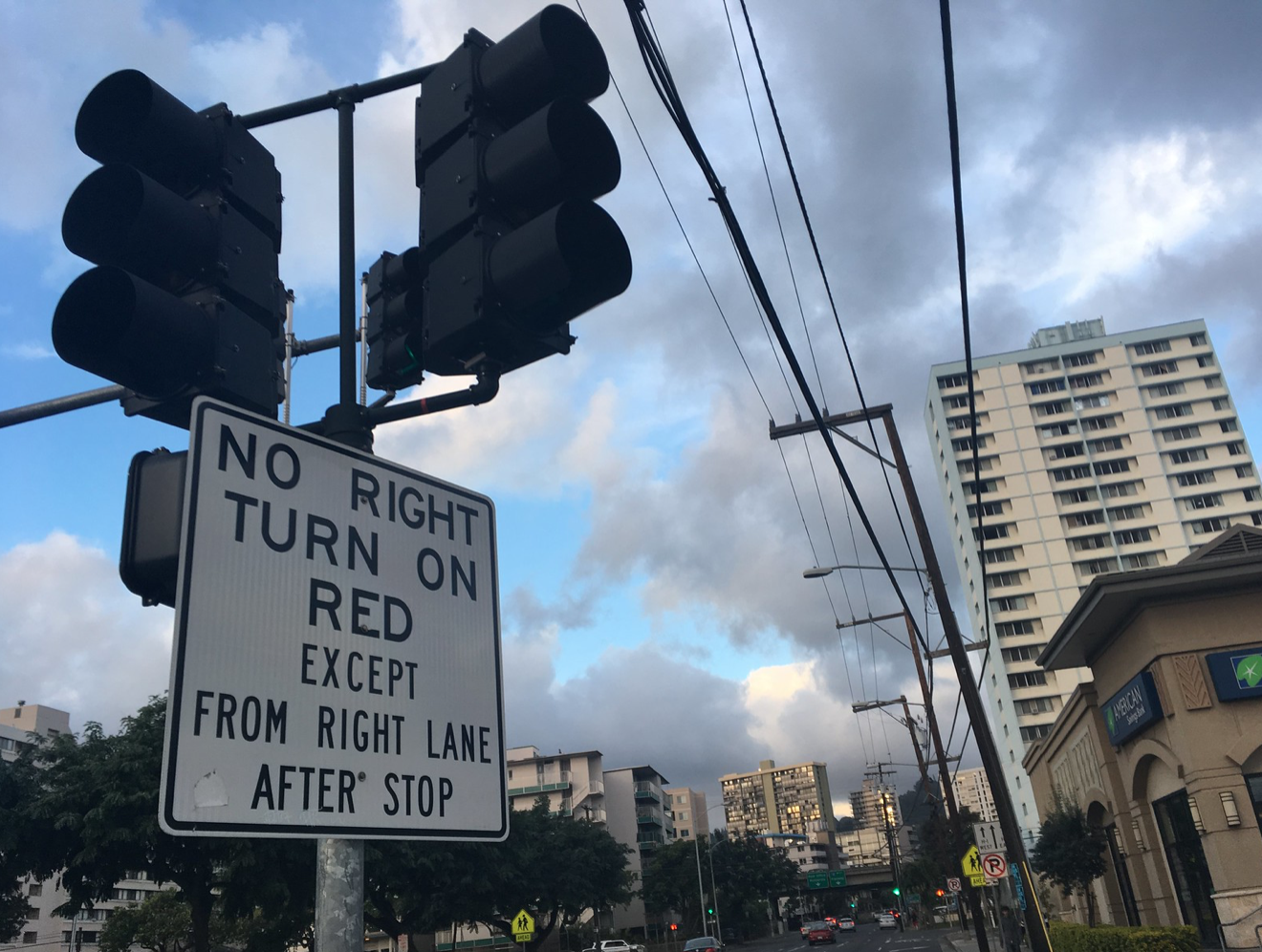Advocates Hope D.C.’s Proposed Right-On-Red Ban Will Inspire National Reform
12:01 AM EDT on September 28, 2022
The nation's capital is poised to become the second major city in the United States to repeal a dangerous law that allowed drivers to make right turns at red lights — and some advocates believe other communities are overdue to follow.
In a preliminary vote last week, the Washington, D.C. council unanimously approved the Safer Intersections Act, which will prohibit right-on-reds except at designated intersections, as well as allow cyclists to treat stoplights as yield signs, since they'll, ostensibly, no longer have to worry about "right-hook" crashes with drivers. (Warning: footage depicted in the previous link may be disturbing.) The proposal, which still must pass a final vote, would go into effect in 2025, contingent upon (because this is the District of Columbia) Congressional approval.
But if it passes, D.C. will join New York City as one of just two major metropolitan areas in the U.S. that have made the reform.
A pedestrian perspective of a driver attempting a right on red. Thank you DC Council for voting to ban this dangerous behavior! pic.twitter.com/RcJU8l95CH
— Mark Sussman | @MarkSussman@thepit.social (@MarkSussman_) September 27, 2022
Street safety advocates hailed the news — and questioned why the dangerous maneuver was ever allowed at all.
Rights-on-red are currently illegal throughout much of Europe, and they were also banned throughout much of the U.S. prior to the 1975 Energy Policy and Conservation Act, whose authors argued that the U.S. could cut down on emissions and fuel usage by allowing them. Under the law, states still can't receive federal funding from what is now known as the State Energy Program unless they allow drivers to turn against the stoplight — despite the fact that the program, which was once helped states create sweeping energy conservation plans, is now largely used to weatherize buildings and isn't even administered by the Department of Transportation.
It’s a small inconvenience for drivers with a big potential payoff. In DC, several people have been killed this summer when large trucks turned right on red and didn’t see cyclists coming in the bike lane. This would make streets safer for everybody.
— Kalisha Holmes (@Kalisha_Holmes) September 21, 2022
Opponents of right-on-red laws, though, say that there are better ways to save on idling emissions today, including the advent of electric and other fuel-efficient cars, modern technologies like "Stop-Start" systems that automatically shut down and restart engines at red lights, and even just creating communities where it's safe and convenient for residents not to drive at all.
Those strategies are all the more important considering the troubling safety trade-offs of right turns on reds. Though motorists are technically supposed to come to a complete stop and confirm that no one is in their path, advocates say many drivers don't — either because they mistakenly believe they have the right of way, or because they physically cannot see a person in an immediately adjacent crosswalk from behind the windshield of an ultra-large vehicle.
A recent Insurance Institute for Highway Safety study found that drivers of the massive SUVs that have saturated the American car market are three times more likely than a sedan driver to hit a pedestrian in their path while turning. Pick-up truck drivers, meanwhile, are four times more likely, thanks to those vehicles' high clearance from the ground and thick "A-pillars" on either side of the windshield, both of which create massive front and side blind zones.
Even before megacars became Americans' favorite way to get around, though, right-on-reds still weren't safe for vulnerable road users. As far back as 1982, researchers had already found that the law increased bicyclist crashes involving right-turning vehicles at signalized intersections as much as 82 percent in some states, while causing pedestrian crashes under those conditions to more than double in others.
Right on red - an exception, not a right of way - destroys the safety of the actual right of way for pedestrians https://t.co/U7LkCFWRjr
— Addison Del Mastro (@ad_mastro) September 27, 2022
Repealing a nearly universal 47-year-old traffic law, though, is never easy — and it may not be in D.C., either.
Despite the fact that the nation's capital already banned rights-on-reds at certain intersections in 2018 and recorded safety improvements for pedestrians and cyclists, opponents of the proposed new law have claimed the council "lacks data" to prove that enough residents were saved from death and serious injury to justify taking the reform district-wide. (The National Transportation Safety Administration made a similar argument in 1995, when it found that less than 1 percent of fatal and injury crashes on U.S. roads involved a right on red — though 22 percent of those crashes involved a bicyclist or pedestrian, and that person was injured a staggering 93 percent of the time, to say nothing of the harrowing impact of near-miss crashes that aren't recorded in federal stats and might scare travelers off of active transportation entirely.)
Others said the restriction causes traffic back-ups that could cost hourly employees a small fraction of their wages, even if it does save lives — an argument that was echoed in local debate over a similar proposed law in Ann Arbor, Mich., and was widely dismissed as outrageous.
Life imitating dril. https://t.co/9auxIh3R03 pic.twitter.com/RItagfMLma
— M. Nolan Gray (@mnolangray) September 22, 2022
Still others worried that the burden of steep fines for red-light turns would fall disproportionately on low-income drivers — even if the District's almost entirely automated enforcement division would likely save them from direct contact with police officers that could lead to violence, particularly for people of color.
Proponents of the ban, though, point out that the council is pursuing separate legislation to hold wealthy recidivist motorists accountable by assessing points on their licenses, too — and that traffic violence, which disproportionately effects D.C.'s Black communities, is an equity concern as well.
“I am very clear-eyed in recognizing that this is a controversial conversation that we are going to have," said Council Member Christina Henderson in an interview with DCist about the latter bill. "I am also very clear in knowing that when we talk about traffic violence, the vast majority of incidents are occurring in communities of color. And so we have to talk about this in a way that deals with that tension.”
If @JerseyCity wants to get serious about #VisionZero they would follow the lead of NYC and DC and ban right on red. @VisionZeroJC @StevenFulop @SafeStreetsJC @bikejc https://t.co/SmT9CFngOv
— Danny Kovarik (@dannykovarik) September 20, 2022
Whatever the fate of DC's right-on-red bill, advocates in other cities are already getting inspired to pursue similar moves in their own communities — and if the Safer Intersections Act passes, it could serve as a template for their efforts.
"There's not much that's complicated about right turn on red: you ban it, or it's legal," said Alex Baca, DC policy director for Greater Greater Washington. "To the extent that other jurisdictions are looking for model legislation, they could gank text from this; to the extent that they are looking for an excuse to do it because someone else has done it and therefore doing so doesn't seem like so much of a liability ...they can [possibly do that too]."
Kea Wilson is editor of Streetsblog USA. She has more than a dozen years experience as a writer telling emotional, urgent and actionable stories that motivate average Americans to get involved in making their cities better places. She is also a novelist, cyclist, and affordable housing advocate. She previously worked at Strong Towns, and currently lives in St. Louis, MO. Kea can be reached at kea@streetsblog.org or on Twitter @streetsblogkea. Please reach out to her with tips and submissions.
Read More:
Stay in touch
Sign up for our free newsletter
More from Streetsblog USA
The 30% of Non-Driving Americans Must Form a Movement: A Conversation with Anna Zivarts
"At the end of the day, there are going to be folks who still can't drive and can't afford to drive — and there are still going to be a lot of us."
Thursday’s Headlines Fight a Suburban War
The way Politico lays out the battle lines, it's not just drivers versus transit users, but urban transit users versus suburban ones.
How Car-Centric Cities Make Caring For Families Stressful — Particularly For Women
Women do a disproportionate share of the care-related travel their households rely on — and car-focused planning isn't making matters easier.
Wednesday’s Headlines Build Green
A new bill dubbed "Build Green" would replace many of the climate-friendly elements Sen. Joe Manchin insisted on stripping from the Inflation Reduction Act.
E-Bikes and Creating Financially Sustainable Bike Share Programs
The number of customers using bike share in the U.S. and Canada is now at an all-time high thanks to e-bikes.





